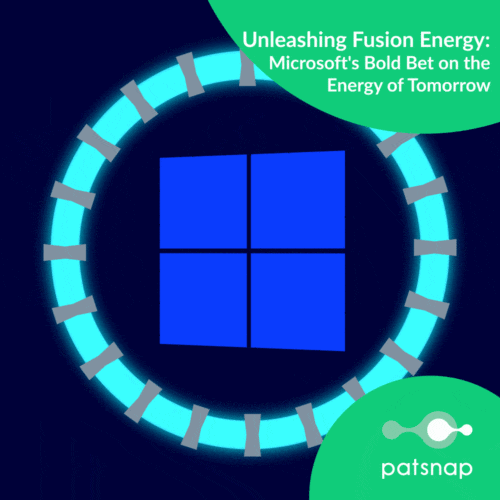Fusion Energy: Microsoft’s Bold Bet
The energy sector stands at the brink of a massive transformation, courtesy of an innovative fusion energy initiative led by Helion Energy. This groundbreaking venture has attracted the influential endorsement of tech titans such as Sam Altman, CEO of OpenAI, and Facebook’s co-founders Reid Hoffman and Dustin Moskovitz.
In this article, we’ll explore what fusion energy is, the benefits it offers, and Helion Energy’s new initiative.
Jump to . . .
- What is Fusion Energy?
- Fusion Energy Vs Traditional Energy
- Benefits of Fusion Energy
- Microsoft’s Partnership with Helion

What is Fusion Energy?
At its core, fusion energy involves combining light atomic nuclei, typically isotopes of hydrogen, to form heavier elements, releasing an enormous amount of energy in the process.
The fusion reaction occurs under extreme conditions of temperature and pressure, creating a plasma state where atoms lose their electrons and become highly energized. By controlling and confining this plasma, scientists and engineers seek to achieve a self-sustaining fusion reaction, producing a substantial and continuous supply of energy.
Fusion Energy Vs Traditional Energy
Unlike fossil fuels, such as coal or oil, fusion energy relies on a nearly inexhaustible fuel source: isotopes of hydrogen found abundantly in seawater. This eliminates concerns about resource depletion and geopolitical tensions related to fuel availability.
In terms of environmental impact, it offers a remarkable advantage over fossil fuels and even conventional nuclear power. It produces no greenhouse gas emissions during operation, contributing to a cleaner and more sustainable future.
Additionally, fusion reactors do not generate long-lived radioactive waste, reducing concerns about nuclear waste management and storage.
Another key distinction lies in energy density. Fusion reactions release an incredible amount of energy. A small amount of fusion fuel can generate a vast quantity of power, making fusion highly efficient and resourceful. This high energy density implies that fusion has the potential to provide a significant and continuous energy supply to meet the growing global demand.
Benefits of Fusion Energy
Fusion energy has transformative potential in the sector, bringing numerous benefits:
- Abundant and clean power: Fusion energy offers a nearly limitless supply of clean electricity, reducing reliance on fossil fuels and cutting greenhouse gas emissions.
- Energy security and independence: Fusion energy utilizes globally available isotopes, enhancing energy security and reducing dependence on specific regions or countries.
- Sustainable development: Fusion energy aligns with sustainable goals, providing clean power with minimal environmental impact.
- Economic growth and job creation: Developing fusion energy requires substantial investments, driving economic growth and creating job opportunities.
- Global energy access: Fusion energy can provide reliable electricity to underserved areas, promoting economic development and improving living standards.
- Decentralized energy systems: Compact fusion reactors enable localized power generation, reducing transmission losses and enhancing energy network efficiency.
- Carbon-free industrial processes: Fusion energy’s high-temperature plasma can replace fossil fuel-based heat sources, reducing carbon emissions in various industries.
- Space exploration and beyond: Fusion energy can power long-duration space missions and support colonization efforts on other planets.
While challenges remain, successful fusion energy development holds immense potential to create a clean, abundant, and sustainable future for generations to come.
Microsoft’s Partnership with Helion Energy
Microsoft is betting on fusion energy. The company recently joined forces with Helion Energy, a leading player in the field, in pursuit of a fusion energy breakthrough. Helion aims to deliver fusion-generated electricity to Microsoft by 2028.
Nuclear fusion, often referred to as the “Holy Grail” of energy, has been an elusive goal for scientists for decades. While estimates for the first operational fusion power plant vary, Helion Energy remains undeterred in its pursuit of groundbreaking advancements within a short timeframe.
While the ambitious timeline raises doubts among experts, Helion Energy’s commitment is backed by a binding agreement with Microsoft. The agreement includes financial penalties if the fusion system fails to materialize, underscoring the company’s determination to succeed.
This ground-breaking collaboration not only exemplifies the power of public-private partnerships but also signals a growing recognition of the immense potential that fusion energy holds for a sustainable future. With the involvement of influential players like Microsoft, the fusion sector gains significant credibility and resources, propelling the industry forward and paving the way for a paradigm shift in global energy production.
With an ambitious long-term target to deliver power at just $0.01/kWh—about half the cost of the cheapest onshore wind generation globally—Helion is truly shaping up to redefine the standards of sustainable power generation.